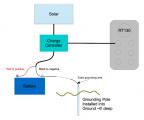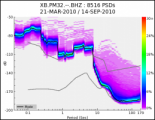
Grounding of remotely-powered stations (
not AC-powered), for stations
where static charge is a problem.
This note concerns only those stations utilizing a remote autonomous power system and solar panels. Systems that will be using AC power should contact the PIC staff for more information on safely using these types of power sources.
Grounding of DAS units should only be attempted in extreme cases where static charge is a problem (for example, failing equipment such as external GPSes). Attempts to ground DAS units can lead to ground loops if not properly done, or even if done to best practices! It should only be attempted when the sensor itself has been isolated from ground by a non-conducting plate such as a tile or phenolic pad. Pads which are not part of the original vault design can also cause stability/noise problems, and must be well coupled to the base of the vault or concrete.





